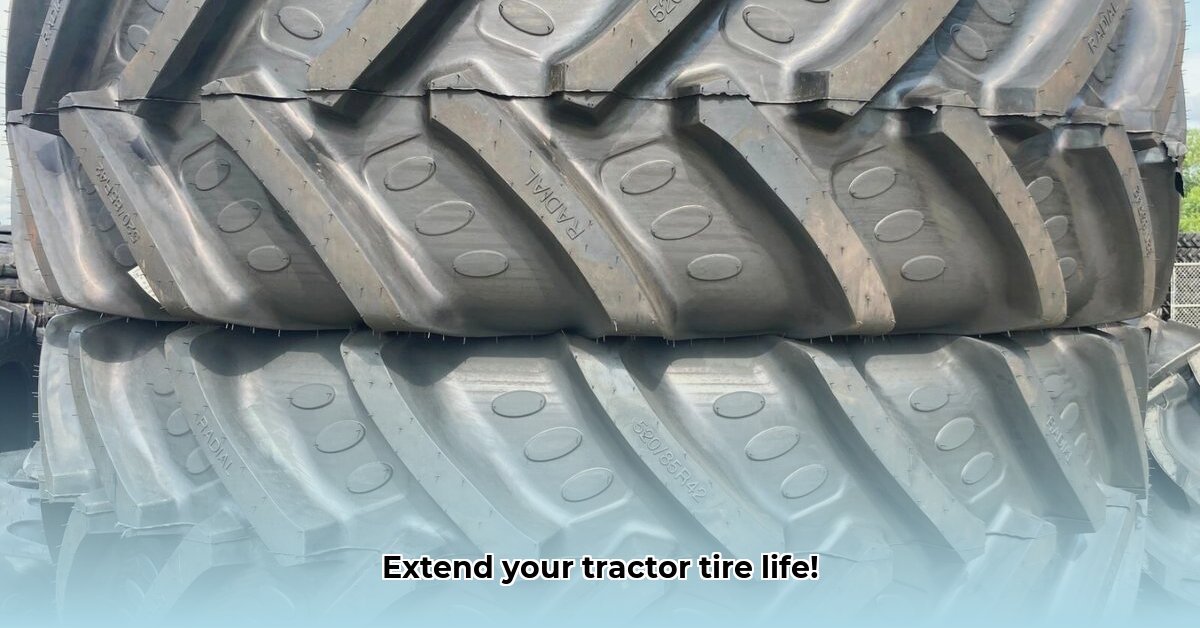
Understanding Your 14.9-24 Tractor Tires: The Foundation of Longevity
14.9-24 tractor tires are workhorses, crucial for a wide range of agricultural tasks. Their size makes them versatile, suitable for everything from plowing fields to hauling equipment on smaller tractors. However, their lifespan isn't predetermined; it hinges on several key factors, primarily proper maintenance and informed choices. Let's explore these factors to maximize your investment and minimize downtime. For more information on tire valve maintenance, check out this helpful resource: Tire Valve Maintenance.
Factors Affecting 14.9-24 Tractor Tire Lifespan: A Deeper Dive
Several elements significantly influence how long your 14.9-24 tires will last. The first and most critical is proper inflation. Underinflation causes excessive flexing and wear, leading to premature failure. Overinflation, on the other hand, stresses the tire sidewalls, increasing the risk of punctures and uneven wear. Always consult your tire's sidewall markings for the recommended pressure and check it regularly using an accurate gauge. Don't forget to account for seasonal temperature changes that affect air pressure.
Soil type also matters greatly. Hard, rocky ground accelerates wear compared to softer earth. The tread pattern plays a significant role here. Deep, aggressive treads excel in mud and loose soil, but they wear down faster on hard surfaces. Conversely, smoother tires are gentler on roads and hard-packed soil but offer less grip in challenging conditions. Selecting the correct tread pattern for your typical operating conditions is essential for optimizing your tire's lifespan.
Driving habits contribute substantially to tire wear. Avoid abrupt stops, harsh turns, and excessive speeds; these actions place undue stress on the tires. Controlled driving is not just safer but also extends your tires' life. How much does your driving style affect your tire lifespan? Consider adopting smoother driving techniques to significantly reduce wear and tear.
Maintaining Your 14.9-24 Tractor Tires: A Practical Maintenance Schedule
Regular inspections are non-negotiable. Just as you'd maintain other farm equipment, consistent tire checks are essential for early detection of problems. A weekly pressure check, using a reliable gauge, is paramount. A monthly visual inspection should detect cuts, embedded objects, or unusual wear patterns. Annual professional inspections are highly recommended to identify issues that may not be visible to the untrained eye; this can include tire balancing to avoid uneven wear.
Here's a practical maintenance plan:
- Weekly: Check tire pressure and adjust as needed.
- Monthly: Perform a thorough visual inspection for damage.
- Annually: Professional inspection and balancing.
Rotating your tires periodically (every 50-100 hours of operation, depending on usage) helps distribute wear, extending their overall life.
Choosing the Right 14.9-24 Tractor Tire: A Tailored Approach
Selecting the right tire is crucial for optimal performance and longevity. Consider these factors:
- Soil type: Sandy, clay, or rocky soils require different tread patterns.
- Typical tasks: Heavy plowing needs more aggressive treads than light hauling.
- Budget: Higher-quality tires often offer a longer lifespan, offsetting the initial higher cost.
The table below highlights the pros and cons of various tread patterns:
| Tread Pattern | Pros | Cons | Best Suited For |
|---|---|---|---|
| Aggressive (Deep lugs) | Excellent traction in mud and loose soil | Faster wear on hard surfaces; rougher ride | Wet, muddy, loose soil conditions |
| Moderate (Mid-depth lugs) | Good all-around performance; balance of traction and longevity | Not ideal for extreme conditions | Most common farming situations |
| Smooth (Shallow lugs) | Longer life on hard surfaces; smoother ride | Reduced traction in mud or loose soil | Primarily road use; hard-packed fields |
Cost Considerations: A Long-Term Perspective
While the initial cost of tires is a factor, the long-term cost of premature tire failure due to neglect or improper selection far outweighs investing in proper maintenance and selection. Preventing issues saves money in the long run. A well-maintained tire lasts longer, leading to improved cost-effectiveness.
Troubleshooting Common Issues: Addressing Problems Proactively
Addressing problems promptly is key to preventing larger, more costly repairs.
- Uneven wear: Often indicates incorrect inflation or alignment issues.
- Cuts and punctures: Requires prompt repair or replacement. Ignoring small cuts can lead to blowouts.
- Rapid wear: May suggest excessive hard-surface use or aggressive driving.
By taking proactive steps—from proper inflation and regular inspections to informed tire selection and mindful driving habits—you can significantly extend the lifespan of your 14.9-24 tractor tires, reducing operational costs and boosting the efficiency of your farm operations. Remember, a proactive approach to tire maintenance is the key to maximizing your investment and minimizing downtime.